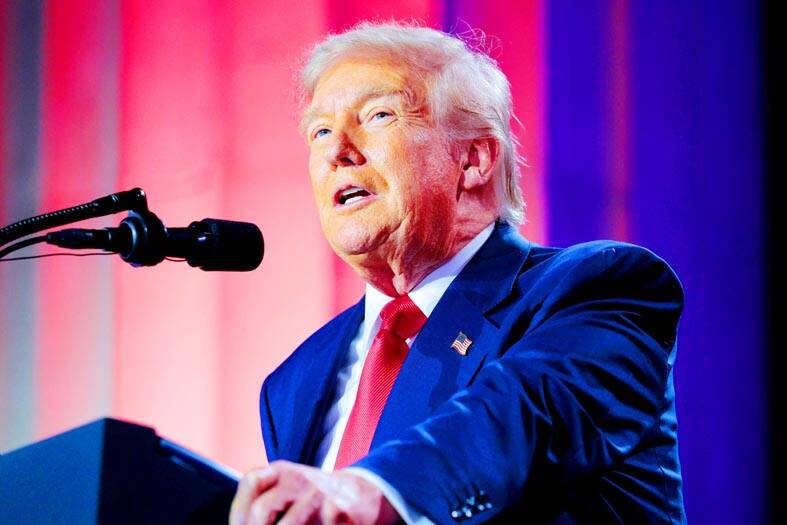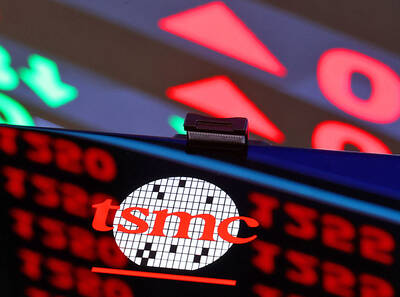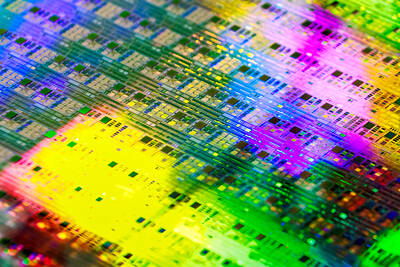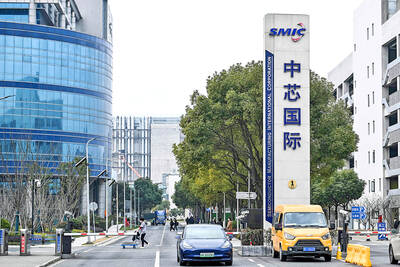US President Donald Trump on Wednesday suggested that he would not go below 15 percent as he sets so-called “reciprocal tariff” rates ahead of a deadline on Friday next week, an indication that the floor for the increased levies was rising.
“We’ll have a straight, simple tariff of anywhere between 15 percent and 50 percent,” Trump said at an artificial intelligence (AI) summit in Washington. “A couple of — we have 50 because we haven’t been getting along with those countries too well.”
Trump’s comment declaring that the tariffs would begin at 15 percent represented the latest twist in his effort to impose duties on nearly every US trading partner, and the latest indication that he was looking to more aggressively impose the levies on exports from countries outside the small group that so far has been able to broker trade frameworks with Washington.

Photo: AFP
Trump earlier this month said that more than 150 countries would receive a letter including a tariff rate of “probably 10 or 15 percent, we haven’t decided yet.”
Meanwhile US Secretary of Commerce Howard Lutnick told CBS News on Sunday that small countries, including “the Latin American countries, the Caribbean countries, many countries in Africa” would have a baseline tariff of 10 percent.
On Tuesday, Trump announced he was reducing a threatened 25 percent tariff on Japan to 15 percent in exchange for the country removing restrictions on some US products, as well as offering to back a US$550 billion investment fund.
The White House has also discussed a similar fund with South Korea, a nation also focused on reaching a 15 percent rate, including on autos, people familiar with the matter said.
The Philippines is aiming to bring down its own tariff rate to the 15 percent level from the current 19 percent, Philippine Ambassador to the US Jose Manuel Romualdez said.
Meanwhile, officials in Vietnam are weighing the likely cost of their deal.
Hanoi estimates its exports to the US could decline by as much as one-third if higher tariffs announced by Trump take effect, an internal government assessment showed.
Other nations, including India and members of the EU, are still pushing for an agreement before the heightened tariffs go into effect.
Trump on Wednesday said that he would “have a very, very simple tariff for some of the countries,” because there were so many nations that “you can’t negotiate deals with everyone.”
He said talks with the EU were “serious.”
“If they agree to open up the union to American businesses, then we will let them pay a lower tariff,” Trump said.
The EU and the US appear to be heading toward a possible trade deal, said EU diplomats, which would result in a broad 15 percent tariff on EU goods imported into the US, mirroring a framework agreement Washington struck with Japan.
EU member countries yesterday voted to approve countertariffs on 93 billion euros (US$109 billion) of US goods, which could be imposed should the bloc fail to reach a trade deal with Washington, EU diplomats said.
The European Commission on Wednesday said that its primary focus was to achieve a negotiated outcome with Washington to avert the 30 percent tariffs that Trump has said he would apply on Friday next week.
Additional reporting by Reuters

SEMICONDUCTOR SERVICES: A company executive said that Taiwanese firms must think about how to participate in global supply chains and lift their competitiveness Taiwan Semiconductor Manufacturing Co (TSMC, 台積電) yesterday said it expects to launch its first multifunctional service center in Pingtung County in the middle of 2027, in a bid to foster a resilient high-tech facility construction ecosystem. TSMC broached the idea of creating a center two or three years ago when it started building new manufacturing capacity in the US and Japan, the company said. The center, dubbed an “ecosystem park,” would assist local manufacturing facility construction partners to upgrade their capabilities and secure more deals from other global chipmakers such as Intel Corp, Micron Technology Inc and Infineon Technologies AG, TSMC said. It

NO BREAKTHROUGH? More substantial ‘deliverables,’ such as tariff reductions, would likely be saved for a meeting between Trump and Xi later this year, a trade expert said China launched two probes targeting the US semiconductor sector on Saturday ahead of talks between the two nations in Spain this week on trade, national security and the ownership of social media platform TikTok. China’s Ministry of Commerce announced an anti-dumping investigation into certain analog integrated circuits (ICs) imported from the US. The investigation is to target some commodity interface ICs and gate driver ICs, which are commonly made by US companies such as Texas Instruments Inc and ON Semiconductor Corp. The ministry also announced an anti-discrimination probe into US measures against China’s chip sector. US measures such as export curbs and tariffs

The US on Friday penalized two Chinese firms that acquired US chipmaking equipment for China’s top chipmaker, Semiconductor Manufacturing International Corp (SMIC, 中芯國際), including them among 32 entities that were added to the US Department of Commerce’s restricted trade list, a US government posting showed. Twenty-three of the 32 are in China. GMC Semiconductor Technology (Wuxi) Co (吉姆西半導體科技) and Jicun Semiconductor Technology (Shanghai) Co (吉存半導體科技) were placed on the list, formally known as the Entity List, for acquiring equipment for SMIC Northern Integrated Circuit Manufacturing (Beijing) Corp (中芯北方積體電路) and Semiconductor Manufacturing International (Beijing) Corp (中芯北京), the US Federal Register posting said. The

India’s ban of online money-based games could drive addicts to unregulated apps and offshore platforms that pose new financial and social risks, fantasy-sports gaming experts say. Indian Prime Minister Narendra Modi’s government banned real-money online games late last month, citing financial losses and addiction, leading to a shutdown of many apps offering paid fantasy cricket, rummy and poker games. “Many will move to offshore platforms, because of the addictive nature — they will find alternate means to get that dopamine hit,” said Viren Hemrajani, a Mumbai-based fantasy cricket analyst. “It [also] leads to fraud and scams, because everything is now